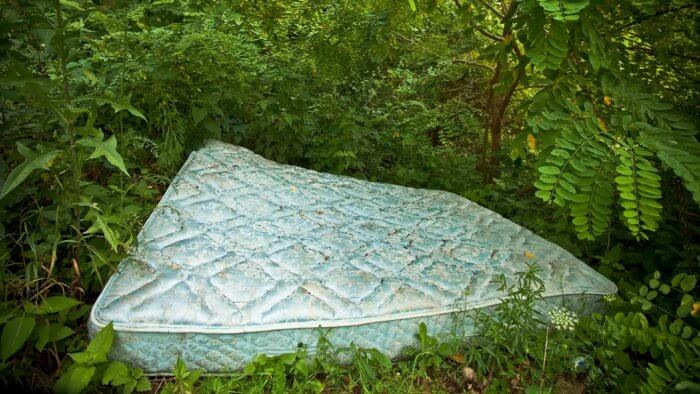Mattresses are incredibly hard to recycle and 8 million go to landfill in the UK each year. Time for retailers to spring into action?
Mattress Recycling: How To Solve A Nightmare Problem
Mattresses are incredibly hard to recycle and 8 million go to landfill in the UK each year. Time for retailers to spring into action?

Hitting the snooze button on mattress recycling responsibilities is simply not an option for retailers any longer.
Historically, disposing of mattresses and other bulky waste streams in a responsible manner has been a real head-scratcher for the UK’s retailers, and understandably so. After all, mattresses are made up of many complex component parts, they’re bulky and there’s an overwhelming number of them.
Up until now, the barriers for mattress recycling in the retail industry have simply been too large and too numerous for many to overcome, but could all of this be about to change?
The problem
Approximately 8 million mattresses, which equates to 167,000 tonnes, are sent to landfill each year in the UK, and this has been the go-to mattress disposal option for homeware retailers for decades due to its low costs.
Further contributing to this gargantuan figure is the public message issued by mattress retailers advising customers to replace their mattress every 7-8 years, shortened significantly from the previous lifespan of 10-12 years.
This means that more than 480 million mattresses will be heading for landfill over the next 60 years – an increase of up to 33 per cent.
So far, the mattress recycling rate hasn’t been able to grow in line with this disposal rate, despite increasing by an estimated 20 per cent from 2012 to 2014. And the situation became still more desperate in 2014-15 as a number of recyclers stopped accepting mattresses.
So now, just for a moment, imagine you are the head of a major UK retailer offering mattress replacement and removal services for your customers.
Sure, you’re left with thousands of very happy customers, but you’re also landed with one very problematic by-product: an ever-growing mountain of mattresses that needs to be disposed of, and no clear way of doing so.

Millions of mattresses go to landfill each year , or even worse are dumped by the side of the road
What do you do?
With limited funds to spend on disposal and no cost-effective, time-efficient way of recycling, that landfill option is starting to look really appealing again. But even this option is becoming less and less viable, with the government continuing to raise landfill tax to hit its target of reducing landfill waste by 50 per cent by 2020.
And on top of these issues, there is an increasing amount of pressure on businesses to implement strong CSR strategies and take a triple bottom line (TBL) approach to activities.
Together these efforts help generate revenue through reducing waste, improving energy efficiency and generally becoming more appealing to environmentally-conscious customers.
The TBL approach has been gaining momentum over the past decade, and more and more retailers are implementing sustainability strategies to respond to the needs of their customers and hit their zero waste to landfill targets, but establishing a viable and efficient recycling policy when it comes to mattresses remains an uncomfortable and seemingly insurmountable task for many.
The good news is that many retailers are aware of their recycling shortfalls, and are actively seeking better solutions for their mattress waste than landfill. The hindrance is simply the logistics and cost.
Technology springs into action
In a bid to help tackle the landfill crisis and improve the efficiency of mattress recycling, some of the UK’s brightest minds have been working behind the scenes to develop the technology to streamline processes and give retailers truly viable options for mattress recycling.
One such bright mind is Nick Oettinger, managing director at The Furniture Recycling Group (TFR Group), one of the UK’s largest mattress recyclers.
Launched in 2012, the company is behind some of the most revolutionary recycling machinery in the industry, and continues to invest in systems that make the recycling of mattresses more viable and efficient for retailers.
It can recycle up to 7,000 mattresses a week, but by mid-2018 TFR Group expects this capacity to grow to 20,000 mattresses.
As part of this work, TFR Group has also designed and prototyped a revolutionary system that will allow a standard 40ft trailer, that ordinarily carries 90 mattresses, to carry 600 mattresses, meaning a significant reduction in transportation costs, another major barrier for retailers looking to recycle bulky waste.
And the efforts of TFR Group do seem to be paying off, with the company recently receiving praise from one of the very retailers these new systems seek to help, John Lewis.
Mattresses make up a major part of John Lewis’ home product offering, as does its customer mattress disposal and recycling service, so the retailer struck up a partnership with TFR Group to ensure its customers’ old mattresses were efficiently recycled.
As a result of this partnership, John Lewis was able to collect and recycle approximately 58,000 old mattresses from customers in 2016 alone, and in a financially viable way. This diverted around 1,500 tonnes of waste from landfill and is a positive step towards closing the gap between mattress disposal and recycling rates.
“We’re very proud that John Lewis chose to work with us to help with their recycling efforts, and it’s so reassuring to see retailers are now thinking about the end of life scenario for their products,” says Oettinger.

John Lewis sells a lot of mattresses and has acted to help recycle old ones
The Future
With such a strong example set by this corporate partnership, the future for other mattress vendors looks considerably more comfortable.
The increased efficiency of the recycling process, combined with the reduced transportation costs involved in getting materials to recycling facilities, will mean more and more retailers will feel able to dedicate the funds and resources to the zero waste mission and moving to a TBL approach.
What’s more, TFR Group also ensures the recycled mattress component materials are used in the production of brand new, superior quality mattresses, creating a circular economy with the potential power to stamp out the UK’s landfill culture for good.
With the UK’s retailers on board and a strong circular economy in place, the future of the UK’s sustainability targets also looks brighter.
Take carbon emissions, for example. The UK aims to reduce absolute carbon emissions by 34 per cent by 2021, but the UK mattress manufacturing industry generates 440,000 tC02e in emissions each year.
Now consider the fact that if just 50 per cent of mattresses were to be manufactured using recycled materials, C02 emissions would be reduced by 34 per cent, a very significant reduction indeed.
“The UK still has a very long way to go to balance the scales and create a truly circular economy,” says Oettinger.
"However, with our research and the determined commitment of the UK’s retailers to make significant changes, we will soon be able to offer the unprecedented levels of mattress recycling needed to help Britain meet its tough sustainability targets."
With the circular economy TFR Group hopes to establish, the target for reduction in carbon emissions, along with the EU target to reduce waste to landfill by 50% by 2020, suddenly seems much more achievable.
So perhaps the snooze button has, indeed, finally been removed, and the UK’s retailers are waking up to the reality of mattress waste. Here’s to the circular economy.
Thanks for signing up to Minutehack alerts.
Brilliant editorials heading your way soon.
Okay, Thanks!

